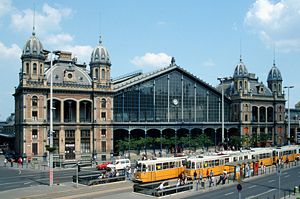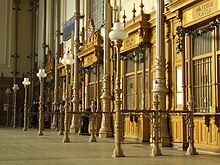Budapest Nyugati pályaudvar
| Budapest Nyugati pályaudvar | |
|---|---|
|
Reception building (2003)
|
|
| Data | |
| Design | Terminus |
| IBNR | 5500728 |
| opening | July 15, 1846 (Pesti indóház) October 28, 1877 |
| Architectural data | |
| architect | Gustave Eiffel |
| location | |
| City / municipality | Budapest |
| city | Budapest |
| Country | Hungary |
| Coordinates | 47 ° 30 '39 " N , 19 ° 3' 27" E |
| Railway lines | |
|
|
| List of train stations in Hungary | |
The station Budapest Nyugati pályaudvar (abbreviated Nyugati pu to German: Westbahnhof ) is after the station Keleti pályaudvar (Eastern Railway Station) and outside the station Déli pályaudvar (South Railway Station) is the second largest train station of the Hungarian capital Budapest .
From an architectural point of view, it is considered to be the most interesting station building in the city.
location
The station is located on Nyugati tér in the Pest district in VI. District. To the north is one of the largest shopping centers in Budapest, the Westend City Center .
Connection to public transport
Immediately in front of the train station on Nyugati tér is the Nyugati pályaudvar stop of the M3 metro line of the Metró Budapest .
In addition, several tram lines stop there, which on the one hand circumnavigate the Pest city center and on the other, like the bus lines that also stop there, cross the Danube to the Buda district .
links
Although the train station on the east side of the Danube in Nörd is handy part of Pest, they decided on the name Westbahnhof because from here the trains to the west, especially after Vienna drove off.
Today trains go from here to the east of the country.
history
From here on July 15, 1846, Hungary's first steam-powered train drove to Vác, about 35 kilometers up the Danube . From then on, the age of the railway began in Hungary. In the years 1890 to 1914 alone, over 11,000 kilometers of track systems were built, which corresponds to about half of today's ( as of 2000 ) rail network.
Many interesting station buildings were built, some of which had special waiting rooms with marble walls and elegant interiors for royal visits. The waiting room for the royal family has also been preserved in the Westbahnhof building, recognizable from the outside by the motto of King Franz Joseph above the entrance ; Viribus unitis (German: with united forces ).
At the end of the 1980s , the building fabric was heavily marked by age. However, the city had no money to renovate the building. In 1990 they looked for an investor for the former train station restaurant and found him in the fast food group McDonald’s . It was not easy to adapt the architecturally interesting space of the station restaurant to the needs of a modern fast-food restaurant. But it was possible to combine both in an overall concept and to take up the typical Budapest coffee house tradition in the form of a McCafé . The café is supplied with cakes and pastries from Café Gerbeaud , one of Budapest's most famous coffee houses.
construction
The official tender for the construction of the station was won by the Parisian architecture firm “Eiffel & Cie” Gustave Eiffels, which achieved world fame a few years later with the construction of the Eiffel Tower . The current station building was built between 1874 and 1877 as a replacement for the original station building, which no longer met the requirements of the rapidly growing rail traffic. It was designed as a typical terminus .
Construction of the main hall began in 1874, although the difficulty lay not only in the architecture, but also in not disrupting rail traffic in the old station concourse built in 1846 below. It was decided to build the new, larger hall over the old hall while the railway was in operation. In 1877 the construction of the imposing iron structure was completed and the old station hall was removed.
The railway depot was inaugurated in 1911 and is now the Budapest Railway History Park, the largest railway museum in Europe.
architecture
The large glass facade of the Westbahnhof with the three wide entrance doors is striking. Behind it is the steel and glass central hall by the architect Gustave Eiffel, which is characterized by its transparency and lightness. Noteworthy is the station restaurant, which is now operated by an international fast food company, but has largely been preserved in its original form.
Eiffel used the Polonceau girder developed by a French railway engineer in the first half of the 19th century . This special type of carrier was ideal for wide-span train stations and was used for many famous train stations, such as B. used the Gare du Nord in Paris . At the beginning of the 20th century, the principle of the Polonceau truss was mainly used for the construction of sports halls.
Data
- Length of the station halls: 146 m
- Span of the halls: 42 m
- Height of the central hall: 25 m
Nostalgia trips
The Hungarian railway company MÁV offers rides on nostalgic Hungarian trains as part of its summer program. From the beginning of April to the end of October, trains run from the Westbahnhof to the Danube Bend every second Saturday .
Once a year, the historic, imperial Sissi train travels from Nyugati station over the old tracks to Gödöllö , where Gödöllö Palace , the favorite palace of Empress Elisabeth at the time, is located. On this occasion, the imperial waiting room is also temporarily opened and made accessible.
Movie
- Railway station cathedrals - Europe's travel palaces. Budapest. (OT: Gares d'Europe, les temples du voyage. Budapest. ) Documentary, France, 2018, 43:05 min., Script and director: Jeremy JP Fekete , production: Yuzu Productions, arte France, ServusTV , series: Bahnhofskathedralen - Europe's travel palaces (OT: Gares d'Europe, les temples du voyage ), first broadcast: October 26, 2018 on arte, synopsis by ARD .
Web links
- Timetable information. (Enter Budapest-Nyugati)
- Budapest Nyugati Pályaudvar Railway Station. In: budapestvacationservice.com. Budapest Vacation Service, archived from the original on April 13, 2015 ; accessed on November 28, 2018 (English).
- Nyugati pályaudvar metro station
- The reception building of the kkpriv. State railway company in Budapest. : Allgemeine Bauzeitung , year 1883 (online at ANNO ).
Individual evidence
- ↑ Documentary: Station Cathedrals - Europe's Travel Palaces. Budapest. In: ARD / arte , October 26, 2018.




